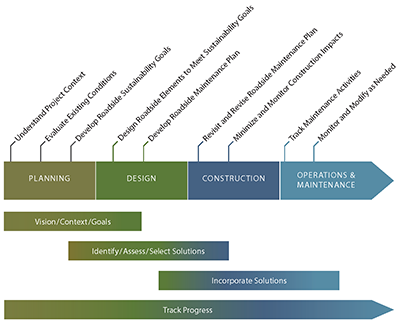Previous Chapter « Table of Contents » Next Chapter
This guidebook identifies four of the major disciplines involved in roadside design and provides strategies to consider in enhancing sustainability. The strategies are intended to be integrated into an agency's existing design process, rather than as a separate set of recommendations.1 Sustainable solutions should be incorporated early in the planning and design processes in order to maximize their value.
CONTEXT-SENSITIVE SOLUTIONS (CSS)
CSS is a collaborative, interdisciplinary, holistic approach to the development of transportation projects (FHWA, www.contextsensitivesolutions.org). It involves all stakeholders, including community members, elected officials, interest groups, and affected local, state, and federal agencies. CSS puts project needs and both agency and community values on a level playing field and con- siders all trade-offs in decision making. CSS should be incorporated into decisions related to the roadside - not simply for aesthetics but for the overall function and character of the facility.
The detailed guidance within this guidebook will vary based on the unique context of the project and type of project (small-scale to large-scale). Overarching recommendations to integrate sustainability into the roadside design process (regardless of scale) include:
INFRASTRUCTURE RATING SYSTEMS
A number of green infrastructure rating systems have evolved over the past few years to measure the concept of sustainable transportation. Each rating system has different applications and review processes. FHWA has created the web-based FHWA Sustainable Highways Self-Evaluation Tool, referred to as INVEST (Infrastructure Voluntary Evaluation Sustainability Tool). INVEST represents a collection of best practices to measure sustainability during the system planning, project development, and operations and maintenance phases. Many of these credits extend beyond the planning phase
to the roadside restoration phase, including lifecycle cost analysis, habitat restoration, protection of riparian habitats, ecological connectivity, recycle and reuse of materials, contextual site vegetation, and others.
CLIMATE VARIABILITY IMPACTS

The idea that the Earth's climate is changing has become widely accepted within the scientific community, and there is strong evidence that many changes to the climate are already taking place. Rising sea levels, increased average global temperatures, increased heat waves, and an increased intensity of storm events have already been observed and are projected to become more extreme over the course of the 21st century.
Long-term changes in climate conditions could significantly affect how transportation facilities are designed, constructed, operated, and maintained. Sea-level rise could threaten coastal infrastructure, such as coastal highways, railroads, and ports. Extended heat waves could cause pavement to buckle. Increased frequency of the freeze/thaw cycles has the potential to significantly affect pavement lifespan and designs. Strategies to address climate change include assessing the risks and impacts that projected climate variability could have on existing assets and how climate variability could be incorporated into the planning and design of new assets. (Assessing the Impact of Climate Variability on Transportation Infrastructure, 2012).
There are four major phases to roadway design, which are described in greater detail in the companion to this guidebook titled Integrated Approach for Building Sustainable Roads (2013):
The four phases are shown in Figure 2-1. Sustainability considerations for roadsides need to be part of each project phase. A set of recommendations to enhance sustainability are included under each phase below.
Phase 1: Planning and Programming
Phase 2: Design
Phase 3: Construction
Phase 4: Maintenance and Operations

View larger version of Figure 2-1
Figure 2-1: Steps to roadside sustainability through the project lifecycle
1 The FHWA Office of Federal Lands Highway design process is governed by the FLH Project Design and Development Manual (PDDM), 2011. References to sections of the PDDM are made throughout this guidebook. https://flh.fhwa.dot.gov/resources/design/pddm/
2. FHWA RealCost software is available at: https://www.fhwa.dot.gov/infrastructure/asstmgmt/lccasoft.cfm.